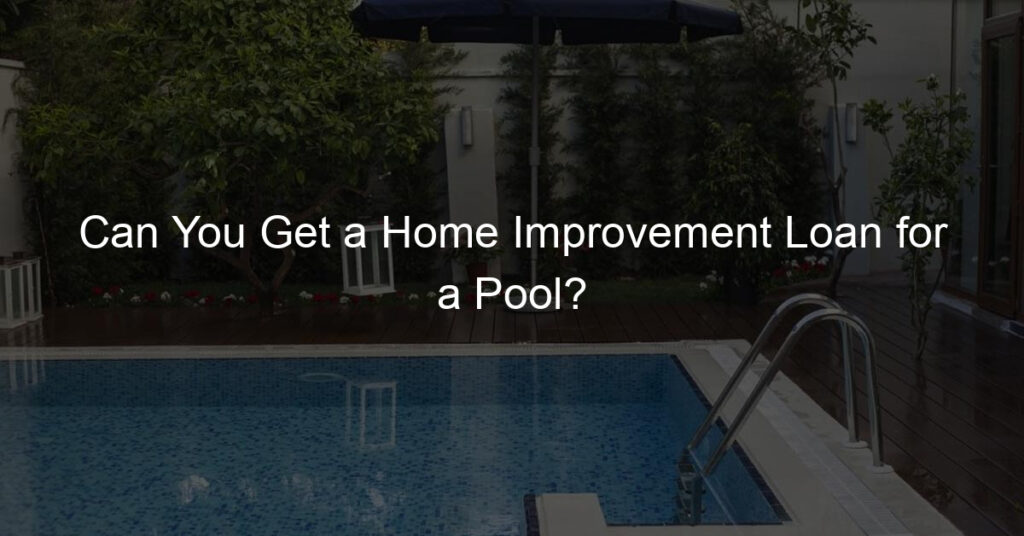Installing a swimming pool in your backyard can significantly increase your home’s value and provide endless summer fun for you and your family. However paying for a swimming pool installation can be quite an expensive undertaking. The good news is that there are multiple financing options available for homeowners looking to get a home improvement loan for a pool.
One popular option to consider is a pool loan designed specifically to help finance the construction or installation of a swimming pool or spa. These loans are typically unsecured, meaning they don’t require your home as collateral. However, there are other financing methods you might want to explore, such as home equity loans, lines of credit, or even personal loans, as each loan type may offer different interest rates and terms based on your creditworthiness.
Before diving into any loan option, it’s important to compare different financing alternatives, understand the cost factors associated with building a pool, and consider the impact of your credit score on pool loan interest rates and terms. Assessing all these factors will enable you to make a well-informed decision and help you enjoy your new pool without stressing over finances.
Key Takeaways:
- Pool-specific loans, home equity loans, and personal loans are common financing options for swimming pool installation.
- Comparing interest rates, loan terms, and credit score impact is crucial for selecting the best financing plan.
- Understanding the cost factors of building a pool can help you plan your budget and choose an appropriate financing option.
Understanding Pool Financing
As someone who’s interested in adding a pool to my property, I’ve discovered that there are different pool financing options available to help me with the costs. Let me share some insights on pool financing that I’ve gathered.
There are two main types of pools: above-ground pools and in-ground pools. Generally, above-ground pools are more affordable, with an average cost of around $11,000. On the other hand, in-ground pools can range from $28,000 to $85,000, depending on the materials, size, and additional features like slides or fountains.
One option to finance a pool project is through a home equity loan. What I like about this method is that it typically comes with a lower interest rate than other forms of borrowing such as credit cards or personal loans. Home equity loans also have fixed interest rates, which provides stability throughout the repayment period.
Another pool financing option is a pool loan. These loans are specifically designed for pools and spas and are usually unsecured, meaning they don’t require any collateral. However, the rates for a pool loan might be higher compared to other secured loans like a home equity loan.
When I was researching pool financing, I found that it’s important to consider the ongoing maintenance costs of the pool as well. On average, maintenance costs can range from $50 to $125 per square foot for in-ground pools.
To sum it up, pool financing can be a helpful way to cover the costs of installing and maintaining a pool. There are various options available, such as home equity loans and pool loans. It’s essential to weigh the pros and cons of each and make sure to include maintenance expenses in your overall pool cost estimate.
Types of Loans for Pool
As I was considering getting a home improvement loan for my pool, I did some research on the various types of loans available. Allow me to share the information I gathered.
Firstly, I came across home equity loans. A home equity loan allows me to borrow against the existing equity in my property. This type of loan typically offers fixed interest rates, which can be helpful for budgeting purposes.
Another option I found was a personal loan. Personal loans can be used for a variety of purposes, including pool financing. They do not require any collateral and are usually unsecured. The repayment terms and interest rates vary depending on the lender and my credit score.
HELOCs, or Home Equity Lines of Credit, are another financing option. Similar to home equity loans, a HELOC also allows me to borrow against the equity in my house. However, HELOCs work like a credit card, with variable interest rates and the flexibility to borrow and repay funds as needed.
Cash-out refinance loans are an alternative if I want to refinance my existing mortgage and take out extra funds for my pool project. This way, I can potentially lower my current mortgage interest rate while obtaining the necessary funds for the pool.
A second mortgage is another option I encountered during my research. This is a separate loan that I can take out in addition to my existing mortgage, using my home as collateral. The interest rates on second mortgages are typically higher than those on the first mortgage.
Additionally, I came across construction loans. These loans are designed specifically for projects like building or renovating a property, which can include adding a pool. The funds are typically released in stages as the project progresses.
Lastly, there are swimming pool loans. These loans are designed explicitly for financing pool installations and can be either secured or unsecured. The available loan options, repayment terms, and interest rates depend on my specific needs and financial situation.
In conclusion, there are multiple financing options to consider when looking for a home improvement loan for a pool. It’s essential to carefully evaluate each option to determine which suits my specific needs and financial situation best.
What Are Home Equity Loans and Lines of Credit?
I’ve come across two popular financing options for a home improvement project like adding a pool: the home equity loan and the home equity line of credit (HELOC). Let me briefly explain what these options are and how they work.
A home equity loan is a second mortgage that allows you to borrow a lump sum of money based on the value of your home. The amount you can borrow is determined by the equity you have in your property, which is the difference between your home’s current market value and the outstanding balance on your mortgage. This type of loan typically has a fixed interest rate and fixed monthly payments over a specific term.
On the other hand, a home equity line of credit (HELOC) is a revolving line of credit secured against your home’s equity, similar to a credit card. You can draw funds up to a certain limit and pay them back over time. The draw period usually lasts for about 5 to 10 years, during which you’re only required to pay the interest on the amount you’ve borrowed. After this period, the repayment phase begins, and you start paying both principal and interest. The interest rate on a HELOC is often variable, which means it can change over time.
Both home equity loans and HELOCs can be used for various purposes, including home improvements like building a pool. While the two options sound similar, they have their differences. Home equity loans offer a one-time lump sum payment with a fixed interest rate, while HELOCs provide ongoing access to funds with a variable interest rate.
To sum it up, home equity loans and HELOCs are two useful financing options when it comes to funding a home improvement project, such as installing a pool. The choice between the two will depend on factors like your financial situation, preference for fixed or variable interest rates, and whether you’re looking to receive the money in a lump sum or need ongoing access to funds.
What is a Personal Loan?
As someone who has researched personal loans, I can share my findings with you. A personal loan is a type of credit that individuals can obtain from financial institutions like banks, credit unions, or online lenders. These loans can be used for various purposes, and in our case, we’re discussing their use for home improvements such as installing a pool.
Personal loans are often unsecured, which means they don’t require any collateral. This is different from secured loans, like home equity loans, which are tied to the value of your home. With unsecured personal loans, lenders rely on the borrower’s credit rating to determine eligibility, interest rates, and loan terms.
One thing I appreciate about personal loans is that they typically have fixed interest rates and fixed repayment periods, which can range from a few months to several years. This makes it easy for borrowers like me to plan and budget accordingly, knowing exactly how much we need to repay each month.
When considering a personal loan for pool installation, it’s essential to shop around and compare offers from different lenders. Look for competitive interest rates, flexible repayment terms, and any additional fees that might be associated with the loan. Keep in mind that a better credit rating can help secure favorable loan terms.
In summary, a personal loan can be a viable option for funding home improvements like a pool. With unsecured personal loans, your credit rating is critical in determining eligibility and loan terms. Always compare offers from different lenders to find the best fit for your needs, and don’t forget to factor in repayment planning when making your decision.
Considerations Before Applying for a Home Improvement Loan
Before I start my search for a home improvement loan to finance the addition of a pool, there are several factors I need to consider. Understanding these aspects will help me make an informed decision when choosing the right loan for me.
The first thing I need to do is evaluate my current financial situation. I’ll take a close look at my income, debt, mortgage, and credit score to determine if I am in good standing to take out a loan. Lenders will want to see that I have a stable income and a low debt-to-income ratio. Additionally, they will check my credit history to assess my ability to repay the loan.
Next, I should research the different types of lenders available, such as banks, credit unions, and online lenders. Each lender may offer different loan options and interest rates. It’s essential for me to weigh the pros and cons of each to choose the right fit for my needs.
It’s also a good idea for me to compare the fees associated with each loan. There might be application, appraisal, or foreclosure fees that I need to consider. Additionally, I should examine prepayment penalties in case I want to pay off the loan early.
Another factor to take into account is the terms of the loan. I need to make sure I am comfortable with the repayment plan laid out in the contract. It’s important to keep in mind the monthly payments and the length of the loan to avoid any financial strain during the repayment period.
Once I have a better understanding of the loan options available to me, I can consider whether to take out a personal loan, a home equity loan, or refinance my mortgage. If I have good credit and can secure a lower interest rate, refinancing my mortgage could be a great option. However, if I prefer a simpler application process and faster access to funds, a personal loan might be more suitable.
Finally, I should think about utilizing a credit card for smaller expenses associated with the pool project, such as hiring a contractor or purchasing materials. This approach can help me manage my expenses and potentially take advantage of cashback or rewards programs offered by my credit card issuer.
By considering all these factors, I will be better prepared to choose the best home improvement loan for my pool project. This will make the process of financing and building my dream pool enjoyable and stress-free.
Interest Rates and Loan Terms
When I’m looking into financing a pool with a home improvement loan, the interest rates and loan terms play a crucial role in my decision-making process. Generally, interest rates for home improvement loans can range from 5% to 36%, depending on the type of project, lender, and borrower qualifications.
As I explore my options, I’ll consider two types of interest rates: fixed and variable. With a fixed interest rate, I’ll have a predictable monthly payment throughout the loan, making budgeting for my pool easier. On the other hand, variable interest rates can start lower but may change over time based on market conditions.
The loan amounts for home improvement projects vary but typically range from $1,000 to $100,000, depending on the scale and complexity of the project. To finance my swimming pool, I need to consider both the initial construction costs and the ongoing maintenance fees. Average costs for an above-ground pool may be around $11,000, while an in-ground pool can range from $45,000 to $85,000 or more.
Repayment terms also influence my decision when financing a pool. Home improvement loans can have repayment terms anywhere between a few months up to several years. I must ensure that I can comfortably manage my monthly payments throughout the duration of the loan.
As a borrower, here are some key factors I should keep in mind:
- Unsecured vs. Secured Loans: Unsecured loans do not require collateral, meaning there is no risk of losing my property if I default on the loan. However, secured loans, which use my home as collateral, often come with a lower interest rate—making them an attractive option if I need to borrow more and have a good credit score.
- APR (Annual Percentage Rate): The APR represents the true cost of the loan, including interest rates and any fees associated with the home improvement loan. Comparing the estimated APRs across providers will be helpful for me to choose the best financing option.
- Loan Amount: The loan amount I apply for should cover the costs for my swimming pool construction while also leaving some room for possible contingencies that might arise during the project. I must also be confident in my ability to repay the loan amount within its repayment term.
In conclusion, as I consider financing my swimming pool with a home improvement loan, I’ll be mindful of the interest rates, repayment terms, and loan amounts involved. By understanding these factors and comparing my options, I can make an informed decision that best suits my financial needs and helps me achieve my dream of having a pool at home.
Cost Factors of Building a Pool
When I decided to build a pool, I realized there are many cost factors to consider before taking the plunge. First, there are two main types of pools: above-ground and in-ground. The average cost for an above-ground pool is around $11,000, while an in-ground pool can set you back anywhere from $45,000 to $85,000 or more.
The size of the pool is another crucial cost factor. Naturally, larger pools require more construction materials and labor, increasing the overall expense. On the bright side, a larger pool can also improve your home’s resale value.
As for construction materials, these can directly impact the cost of your pool. For example, if you decide on a high-end option like an infinity pool, expect higher costs for building materials and labor. Speaking of labor costs, they can vary depending on your location, the builder’s experience, and the complexity of the pool design.
As a future pool owner, I also needed to factor in maintenance costs. Pool maintenance includes regular cleaning, water testing, and replacing necessary parts, which could amount to around $3,000 annually. Electricity for running the pool pump and heater also adds to the overall maintenance cost.
Financing a pool is another element to consider. Many homeowners opt for a home improvement loan to cover the initial lump sum of building a pool. These loans typically come with attractive interest rates and fixed monthly payments. However, it’s essential to factor in the closing costs of the loan.
Lastly, it’s essential to think about the return on investment (ROI). A well-maintained and visually appealing pool can increase your home’s resale value. However, the return on investment will largely depend on your house’s location and local market demand for swimming pools.
In conclusion, building a pool involves a mix of upfront costs, labor, maintenance, and financing factors. By carefully examining these aspects, you can make an informed decision on whether adding a pool to your property is an excellent choice for you.
The Impact of Credit Scores on Pool Loans
As a homeowner, I’ve been considering adding a swimming pool to my property and decided to explore the financial aspects of it. I discovered that my credit score has a significant impact on whether I can secure a home improvement loan for a pool.
A good starting credit score for getting a pool loan is around 630, as mentioned by HFS Financial. Of course, a higher score would likely result in more favorable loan terms, such as lower interest rates and flexible repayment options. On the other hand, a lower credit score may lead to less favorable terms or less chance of approval.
When looking for a pool loan, it’s essential to shop around and compare offers. I found that websites like NerdWallet, Acorn Finance, and The Mortgage Reports are great resources to help with comparing loan providers and their requirements for credit scores, terms, and payment options. These websites can even provide rate quotes without impacting my credit score during the initial pre-qualification process.
As I continue my journey, I’ve learned that it’s crucial to maintain a good credit score to get the most out of my pool loan options. To achieve that, it’s essential to pay bills on time, keep credit card balances low, and avoid taking on excessive debt. These steps will not only improve my chances of securing a pool loan but also help manage my overall financial health.
In conclusion, obtaining a home improvement loan for a swimming pool largely depends on having a good credit score. By comparing loan offers, maintaining a solid score, and being responsible with my finances, I can be one step closer to enjoying my dream pool in the backyard.
Loan Options Based on Creditworthiness
In my experience searching for home improvement loans, I’ve noticed that creditworthiness plays an important role in the types of loans and interest rates available for borrowers. With that being said, here are loan options suitable for different credit levels:
For Good Credit: If your credit score is in the good to excellent range, you’ll have more options and potentially lower interest rates. Common loan types for good credit borrowers include personal loans and home equity loans. I’ve found that personal loans can have fixed annual percentage rates (APR) ranging from 8.24% to 21.49%, depending on factors like your credit score, loan amount, and loan term.
For Fair Credit: When you have fair credit, you might not have access to as many loan options as someone with good credit, but you can still find affordable loans for home improvements, like a pool. An option to consider is an FHA Title I loan, aimed at providing funds for property improvements, especially to those with lower credit scores. Keep in mind that such loans will likely have higher interest rates compared to loans for borrowers with good credit.
For Bad Credit: If you have bad credit, you may still qualify for a home improvement loan, but with higher interest rates and stricter conditions. One option that may be available for borrowers with less-than-stellar credit is through the FHA 203(k) program. This type of loan allows you to combine the costs of buying and fixing up a home, including adding a pool, into one loan. You’ll qualify with a credit score as low as 500 with a 10% down payment or 580 with a 3.5% down payment.
In my research, I’ve come across some other options that might work well for people with bad credit, like secured loans and home equity lines of credit (HELOCs). Secured loans typically require collateral, such as your home, which may allow you to access funds at a lower interest rate. HELOCs, on the other hand, offer a line of credit against your home’s equity, allowing you to draw funds as needed for your pool project. Keep in mind that both of these options come with risks since you’re using your home as collateral.
Remember, your creditworthiness plays an essential role in the loans and interest rates you may qualify for when looking to finance home improvements like a pool. Start by evaluating your credit score and considering the best options available for your unique financial situation.
Comparing Different Financing Options
As I explore the options for financing a pool, I’ve come across several possibilities. Let’s look at a few and see how they compare.
First, there are online lenders like LightStream, which offer dedicated pool loans with competitive rates. They provide loan amounts ranging from $5,000 to $100,000, making them a great option for various pool sizes and budgets. The advantage of using an online lender is the convenience and speed of the application process, which often results in faster funding than traditional banks.
Another option I discovered is to use a home improvement loan through popular platforms such as HomeAdvisor. These loans can be used to finance a pool, as well as various other home upgrades. The benefit of this route is that I can wrap multiple improvement projects into a single loan, potentially leveraging better rates and terms. HomeAdvisor can connect me with local lenders, which may help with get the best deal.
I’ve also learned that some pool builders collaborate with financing partners to make it easier for customers. The advantage of using a builder-associated lender is the streamlined process since they have experience working together, and fast funding is generally available. However, it’s important for me to compare these partnerships’ rates and terms with other options to ensure I’m getting the best deal.
In summary, while considering which option is best for financing my pool, I’ll thoroughly compare online lenders, home improvement loans through platforms like HomeAdvisor, and builder-associated lenders. I’ll ensure I evaluate each option in terms of rates, loan terms, convenience, and speed of funding before making a choice that’s best for my needs.
Final Thoughts
While researching home improvement loans for pools, I found that it’s possible to borrow amounts ranging from $1,000 to $100,000. The interest rates for such loans may vary between 6% to 36% based on individual creditworthiness and other factors. As someone who values design and customization, I was pleased to discover that these loans can be used for both inground pools and various design features.
One important aspect to consider during this process is the funding time. If I need funds fast, a personal loan may be a suitable option, as they tend to have swifter disbursal periods. However, if I have enough equity in my home and can afford to wait, a home equity loan might be more advantageous due to its lower interest rates.
I appreciate the idea of fixed interest rates and fixed monthly payments that come with home equity loans. As a homeowner, I find it more convenient to plan out my mortgage payments and other expenses when I know my financial obligations are constant. On the other hand, if I choose a personal loan, I should be prepared for the possibility of varying interest rates.
In summary, opting for a home improvement loan for a pool largely depends on my personal financial situation and preferences. I will consider factors like my home’s equity, desired loan amount, interest rates, and funding time while making a decision. With a well-thought-out plan, I hope to transform my backyard into a serene haven without significant burden on my finances.
Frequently Asked Questions
What are the best financing options for a pool?
There are several financing options available for pools, including pool loans, home equity loans, and home equity lines of credit (HELOCs). Ultimately, the best option for you will depend on your financial situation, credit score, and the type of pool you want to install. It’s important to research each option and compare interest rates, loan terms, and other factors before making a decision.
Are there special pool loans available for veterans?
Yes, some lenders offer specialized pool loans for veterans. These loans may have lower interest rates, longer repayment terms, or more flexible eligibility requirements compared to conventional pool loans. It’s a good idea for veterans to explore these options when considering financing a pool.
How do I calculate the interest on a 20-year pool loan?
To calculate the interest on a 20-year pool loan, you’ll need the loan amount, interest rate, and loan term. You can use an online loan calculator to determine the total interest you’ll pay over the life of the loan. Simply input the requested information, and the calculator will provide an amortization schedule outlining the interest and principal paid each month.
What are the typical rates for pool loans?
Pool loan interest rates can vary depending on several factors, including your credit score, loan term, and the type of pool being installed. Generally speaking, pool loan rates can range from 5% to 36%. It’s crucial to shop around and compare the rates offered by different lenders to ensure you’re getting the best deal for your situation.
How do I calculate financing for an inground pool?
Calculating financing for an inground pool involves several steps. First, you’ll need to determine the total cost of the pool, including installation, materials, and any additional features. Next, you’ll need to figure out how much money you can afford as a down payment and subtract that from the total cost. The remaining amount is what you’ll need to finance. Finally, use a loan calculator to estimate the monthly payment, taking into account the interest rate and loan term.
Can I use a home equity loan or HELOC to pay for a pool?
Yes, you can use a home equity loan or HELOC to finance a pool. With a home equity loan, you borrow a lump sum against the equity in your home, while a HELOC provides a revolving line of credit. Both options can offer lower interest rates compared to unsecured loans, but keep in mind that your home is used as collateral, meaning you risk foreclosure if you can’t make the payments. Be sure to weigh the pros and cons before using a home equity loan or HELOC to finance your pool.














